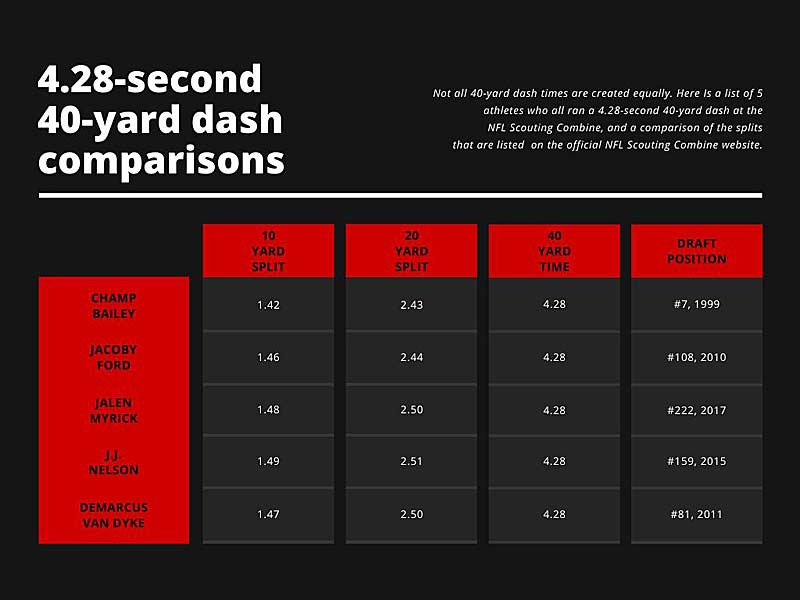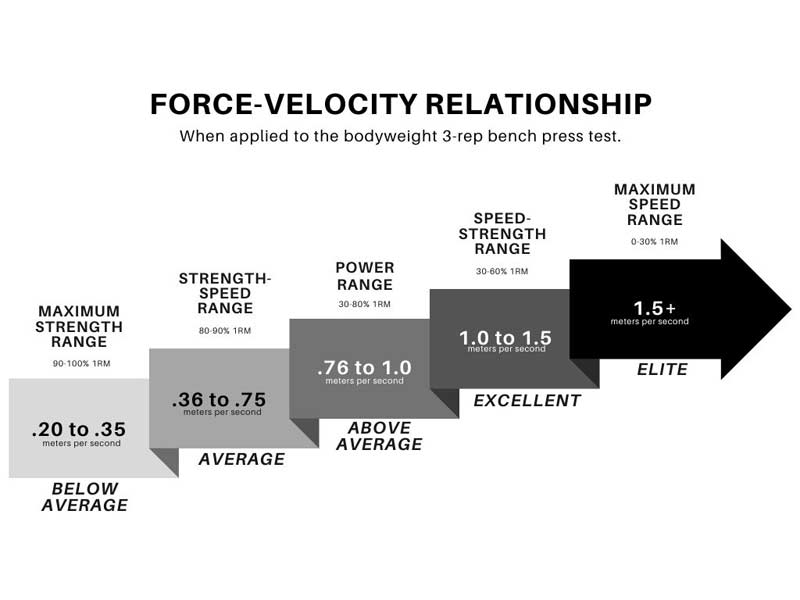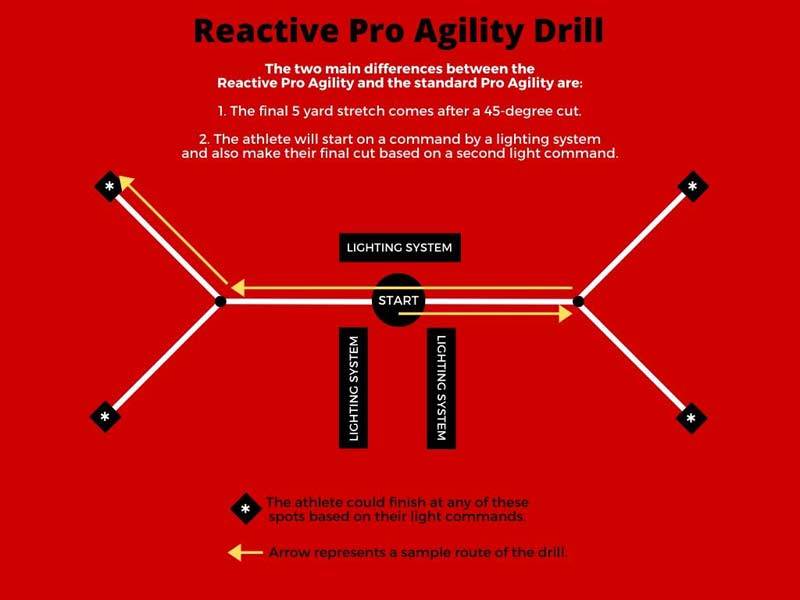[mashshare]
Every year, the NFL Scouting Combine proves to be the biggest job interview for about 250 young men trying to fulfill their lifelong dream of playing in the National Football League. For some, it can enhance their draft stock tremendously. For others, it may have a detrimental impact on their NFL draft position and, ultimately, their career.
Truthfully, I really enjoy the NFL Combine. I live in Indianapolis, which has been the host since 1987, so I had the pleasure of attending the Combine a few times in my professional career before it became a live spectator event. While it may have flaws when viewed through the lens of strength and conditioning, the overall event is run well, it’s inspiring to see the great performances, and it has a positive impact on my city.
The current battery of universal Combine drills may not feature the best choices for displaying an athlete’s potential in the sport, says @JustinOchoa317. Share on XWith that being said, like all coaches involved in football at any capacity, I can’t ignore the fact that the current battery of universal Combine drills may not feature the best choices for displaying an athlete’s potential in the sport. In addition, the style of training leading up to the event may also not be the best choice in terms of physical preparation for football.
Every year, when it’s time for the Combine, we see the resurgence of coaches (including myself) bring up valid critiques on how relevant the Combine process actually is:
- These guys are just training to beat a test/drill…
- What does the 225 bench have to do with playing football…
- The “pro agility” test isn’t really a display of true agility…
Again, these are all valid thoughts that definitely open up some conversation on the topic. If you’re not a fan of the current set of drills, what would you change? I decided to explore that and come up with a hypothetical NFL Scouting Combine 2.0.
Below is my spin on the current Combine drills, what changes I think the NFL could benefit from, and why. For the sake of the article, I only looked at the “Big 6” drills, which everyone typically performs, regardless of position. I don’t take into account things like the Wonderlic Test, player interviews, position drills, injury evaluations, etc.
The “Big 6” consists of:
- 40-yard dash
- 225 bench press
- Vertical jump
- Broad jump
- 20-yard shuttle
- 3-cone drill
#1. Change the 40-Yard Dash (Kind of)
Right off the bat, we have to talk about the most popular drill of the Combine—the 40-yard dash. There is such an obsession over this drill because it focuses on speed, one of the biggest separators in team sports.
This drill can make or break a person’s draft stock, which is ironic because:
- It showcases a lot of top-end speed in a very acceleration- and COD-based sport.
- It’s one of the easier tests to hack with technique and Combine secrets for instant improvement.
- Everyone, regardless of position, runs it. Even though I love to see the hogs get rolling, their 40 time isn’t the most applicable drill option.
The obsession with this drill actually started in the 1940s, long before the Combine became what it is today. The idea behind it, at the time, was that the average punt had a hang time of 4.5 seconds and an average distance of 40 yards. In theory, that meant coaches were looking for guys who could run that distance in that time to be able to efficiently cover punts.
The 40-yard dash evolved into something much greater and even trickles all the way down to the grassroots level. There are so many misguided parents and youth athletes when it comes to speed, football preparation, and the 40 times—it’s truly getting out of control.
The Combine should make better use of time splits in the 40-yard dash and rank positions based on those splits as if they were part of their own separate drill, says @JustinOchoa317. Share on XIt’s clear that the 40-yard dash is here to stay, and it should. However, here’s my proposal for the NFL Combine 2.0. It’s very simple: just make better use of time splits and rank positions based on those splits as if they were part of their own separate drill.

Yes, the NFL already takes splits now, but those numbers are seldom promoted or publicized. I had to dig to create the chart above, which illustrates how different a 4.28-second 40-yard dash can actually look.
We only see the final 40-yard dash time for all players and positions, because that’s what gets the attention of the viewers. Having each individual split as its own metric and its own drill would not only benefit the scouts, but also the athletes and spectators by providing more in-depth info on the drill.
0–10 Yards
This is an essential metric for all potential NFL athletes, because we get to see pure acceleration numbers. The sport of football requires acceleration and change of direction (which is essentially deceleration in one direction with immediate acceleration in another).
This 0- to 10-yard split gives scouts a better look at those power and acceleration qualities, especially if you consider the position each athlete plays. If two offensive linemen have an identical 40 time, but one has a faster 0–10 split, I would think that player has better acceleration power and would be the more enticing draft prospect.
10–30 Yards
We could really look at this as a flying 20. This would be great to see for skill positions. A lot of their work is done in a 20-yard radius and, in many cases, moving from tracking the ball, a player, or a gap and getting to top speed in that direction as fast as possible.
The NFL does capture 10- and 20-yard splits, but again, we never see those numbers. Those still count the drive phase, and I would love to see more of that fly-in speed as a metric of its own.
This isn’t saying the 0–10 or the entire 40 yards isn’t also important; this is simply another metric that can let GMs see the bigger picture. If you’re looking at two prospects with the same 40 time, looking at splits can tell you their strengths and weaknesses, and then you can take the demands of their position into account for further review.
40 Yards
Of course, we have to keep the original 40-yard distance in the mix. The world would come to a burning end if the Combine ever dropped this drill. It’s not a “bad” drill or pointless by any means, I just think using the splits more specifically and more publicly could do a lot of good for all athletes, teams, and spectators.
#2. Velocity-Based Bench Press
While we didn’t completely nix the 40-yard dash, I think the bench press test needs a complete makeover. In my opinion, out of all the drills in the entire Combine, putting 225 pounds on a barbell and getting as many reps as possible has the least translation to the sport.
Is it awesome to watch? Yes. But is it truly a metric that tells a story of what kind of athlete someone is? Not really.
For many of these men, it is not a test of strength at all. Many times, it ends up being more of an endurance drill with rep counts in the 20+ range and time under tension about 1200% longer than the average football play lasts.
I’ve also heard several horror stories of torn pecs and destroyed shoulders as a result of training for the max rep 225 bench press test. That obviously won’t help draft stock or career advancement at all.
Instead, let’s step into the year 2020 and use some technology to better utilize the bench press test at the Combine. My proposal is to use a velocity-based training system to capture bar speed and power output on an athlete hitting their body weight (on the bar) for 3 reps.
I propose making over the bench press test with a velocity-based training system to capture bar speed and power output on an athlete hitting their body weight (on the bar) for 3 reps. Share on XThis is more athlete-specific and sport-relevant. When an athlete puts their own body weight on the bar for this test, the benefits are threefold:
- They’re not going to failure and risking injury (plus, it may be even lighter than 225 for some athletes). If a potential pro athlete can’t bench press their body weight, it can raise some questions—you don’t need a max rep test to determine that.
- This weight is relative to the athlete and the other potential draftees in their position. For instance, 225 pounds for a right tackle is going to look different than 225 for a cornerback. It not only allows you to compare guys who are around the same size/position, but also compare the metrics to other positions with which they may often be paired in a game (e.g., DB and WR).
- We get to look at velocity (speed) and watts (power), which are much more important in the game of football than a redundant weight on the bar for max reps. These figures display speed and power, or possibly a lack thereof.

The test will last about the same amount of time as a football play, tracking athletic qualities that matter during those plays and keeping it relative to each individual with an ability to globally compare in a much safer way. Everyone wins.
#3. Reactive Strength Index Jumping
I won’t beat around the bush… It pains me to say this, but the vertical jump test is gone. I want to make it crystal clear that I am very much in favor of vertical jump testing, but as you read along, you’ll see why it doesn’t make the cut for my new and improved Combine.
The vertical jump is an amazing showcase of force production and athleticism, but I believe the broad jump is just as good. Unpopular opinion: I think it’s even better in some situations.
Showcasing power straight up and down is great, but I love the broad jump because of its horizontal, NOT vertical, displacement. Yes, there is jumping in football. You’re taught to catch balls at the high point, it’s useful for breaking up passes, etc. I totally get that, but so much more of the game takes place on the turf and not in the air. I think the horizontal power production matters more in this case, but we’ll talk more about that later.
My proposal is to swap out the vertical jump test and get a reactive strength index (RSI) reading for each athlete with a box drop jump.
Video 1. A football player performing an RSI box drop jump. I believe we should swap out the vertical jump test at the NFL Combine and use a box jump drop to get an RSI reading.
In a nutshell, RSI is a metric that represents an athlete’s ability to produce maximal forces in minimal time. In the example of the box drop jump, it takes into account jump height versus ground contact time. This scoring system tells us the efficiency of an athlete’s stretch-shortening cycle (SSC), which is an essential function in speed, agility, quickness, and—of course—jumping. The higher the RSI, the better the athlete’s SSC.
Just because someone can jump extremely high doesn’t mean they have an impressive SSC. A slow, high, jump doesn’t really tell us much in relation to football. In fact, many athletes with a slow SSC often have higher maximal strength capabilities, while fast SSC athletes often have higher reactive strength capabilities. For the sake of this test, I think the reactive piece holds more weight due to the nature and demands of the sport. Here’s an example of the same athlete with a slow versus fast SSC on a drop jump.
The vertical jump is cool, but I think using a box jump to get an RSI reading gives us a much better look at the important factors of an athlete’s abilities, says @JustinOchoa317. Share on XI think that people could become obsessed with this test to the same extent they are with the 40-yard dash right now. We actually run this test as part of the intake and monitoring process at our facility, and it’s truly an amazing display of athleticism to see the RSI scores elite athletes can achieve. It’s definitely something our athletes take pride in and love to use to compete against others and themselves.
How cool would it be to see an offensive lineman get a 2.89 RSI score at 300 pounds? That is a guy that I would absolutely love to protect my quarterback.
The vertical jump is cool and all, but I think this type of data tracking gives us a much better look at the important factors of an athlete’s abilities. There are tons of options out there as far as what devices or equipment can track RSI, and it would be one of the more seamless changes on this entire list.
#4. Broad Jump, You Can Stay
As mentioned earlier, I really like the broad jump, both as a training tool and as a test. Obviously, context is key, but in this specific case I chose to scrap the vertical jump, so we can keep the broad jump.
To recap, the main reason for keeping the broad jump over the vertical jump is because of the horizontal displacement expressed in the movement and how that relates to football. That triple extension looks a lot like a sprint, and I love that.
Another reason is that I believe the broad jump is much harder to cheat than a vertical jump. On a manually tested vertical jump, there are many ways an athlete can cheat the system. The NFL obviously runs a tight ship in their testing protocols, but I’m sure athletes can still use some of these to get a slight advantage.
One way an athlete can cheat the vertical test is by limiting their initial reach. You reach up, then jump up, and the difference between those heights is your vertical jump result. This happens at pro days and other combines (especially high school), but maybe not so much on the big stage of the NFL Combine. It is still worth mentioning, though. Athletes can fake how high they can actually reach, making the initial reach lower, which adds to the end results of the jump.
It’s an unpopular opinion, but I think the broad jump is even better than the vertical jump in some situations, says @JustinOchoa317. Share on XAside from that, since this is a reaching jump test, your reach is obviously crucial. I’ve seen athletes access immediate increases in range of motion when it comes to reaching simply by performing some SMR on their lats, triceps, and/or pecs. If you alleviate the neural tone of those muscles, you can get better shoulder flexion. More shoulder flexion results in a better reach overhead, which can help an athlete touch maybe 1–2 more tabs on a Vertec and increase their score.
The broad jump definitely has some technique to it, but for the most part, what you see is what you get, and that is a great thing for Combine testing.
#5. 3-Cone Drill, You Can Stay Too
The 3-cone drill, or “L drill,” is another classic multidirectional drill that can be used in training or testing. In this case, I decided to actually keep this drill as is for the new and improved Combine event.
I really like this drill because it features acceleration, change of direction, and most of all, a little bit of curved running. That curved running piece, even if it is subtle, is really important for football players, as the game is not played on perfectly executed right angles. The game happens in all planes of motion, and I really like how this test features that aspect.
Is this a true test of agility? Not technically, but we can see plenty of different movements in one drill and I think that is still important, even in a closed-circuit environment.
I say all this leading up to the next change, which is to get rid of the “pro agility” test (another fan favorite). Similar to the broad jump versus vertical jump situation, one had to go, and I am in favor of the L drill for the reasons listed above.
#6. Reactive Agility Test
Last, but not least, we arrive at the pro agility test. Also known as the 5-10-5 or the 20-yard shuttle, this is another beloved Combine drill that, unfortunately, has to be replaced.
The 5-10-5 is not a bad drill, but I would propose replacing it with something a little bit more complex to showcase more of an athlete’s true agility. What I think the pro agility drill is missing is the reactionary piece. With today’s training technology and equipment, we can actually expose athletes to a more unpredictable and reactive drill that still requires them to showcase all the agility they would in the standard pro agility drill.
We can use today’s technology to expose athletes to a more unpredictable & reactive drill that still requires them to display the agility they would in a standard pro agility drill. Share on XAs is, the pro agility is another test that is extremely easy to hack for a better score. We know that a better score doesn’t necessarily mean a better athlete. Being good at a test doesn’t always translate to real life. I took Spanish courses in college all the way up to 400-level, no-English-allowed classes, but I can’t speak a lick of Spanish today. I was good at the tests, but it didn’t translate. This is how I feel about this particular test and several others listed above.
Instead, we can add some unpredictable elements to an agility-style drill. The initial setup can be the same as the 5-10-5 with three cones/lines all 5 yards apart, and then beyond the end, two end cones are a set of “finish line” timing gates on each side in the shape of a Y.

The athlete starts in the middle, just as they would on a pro agility test. A screen displays either “L” or “R” to initiate the start of the clock, and as soon as that command comes up, the athlete begins their standard pro agility in that direction. Instead of a 5-10-5 yard sequence, there is a 5-10 sequence and then a 45-degree cut (5 yards) to finish the drill. That cut is also signaled by a timed command of L or R as soon as the athlete crosses the original start line. This gives them 5 yards to read and react to make the proper cut and finish.
We haven’t strayed too far from the original 5-10-5—about half of it is the same—but we’ve added a reactionary piece that I think is a huge indicator of true agility. We’ve also added a change of direction in a different plane of motion with the 45 degrees. This drill is equally as simple, and it will further challenge the athlete not only physically, but mentally as well.
A More Accurate Reading on Athletes
I think this battery of drills for the new and improved NFL Combine 2.0 would be incredibly entertaining to watch, but also give players, coaches, GMs, and fans a better reading on the athletes competing for these draft spots.
Change can be a great thing and athletes have evolved so much over the years. I believe any or all of these changes would have a positive impact on the Combine, says @JustinOchoa317. Share on XIt’s pretty apparent that the NFL loves tradition, but change can be a great thing. Athletes, in general, have evolved so much over the years. The things that people are capable of now are incredible, especially if you compare athletes today to those 30 years ago. While this was a hypothetical makeover of the current Combine from an S&C coach’s perspective, I do believe that any or all of these changes would have a positive impact on the event.
Since you’re here…
…we have a small favor to ask. More people are reading SimpliFaster than ever, and each week we bring you compelling content from coaches, sport scientists, and physiotherapists who are devoted to building better athletes. Please take a moment to share the articles on social media, engage the authors with questions and comments below, and link to articles when appropriate if you have a blog or participate on forums of related topics. — SF
[mashshare]






